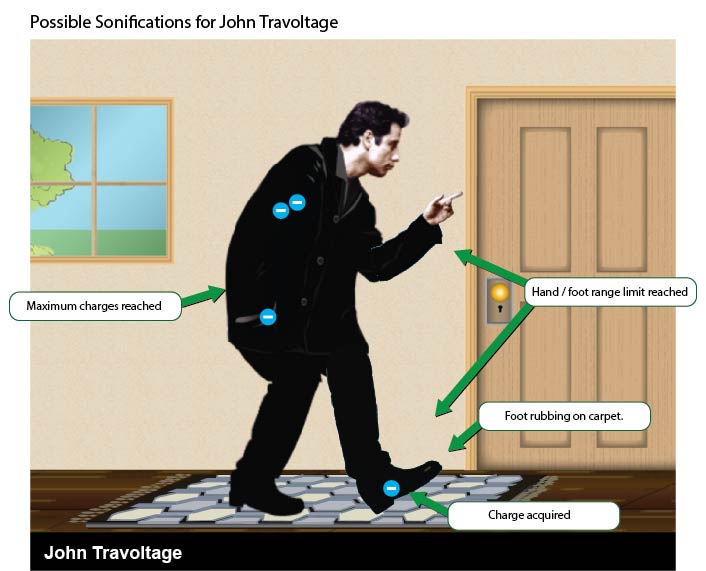Definition
...
- Descending notes indicating the decreasing quantity of charges on JT
- The zapping sound should play for the duration of the discharge.
- The zapping sound should also convey the distance from the hand to the doorknob somehow? A louder zap for closer to the doorknob, and a quieter zap for further away?
...
Charge Acquired
- A tone is played when a charge is acquired.
- The tone increases in pitch indicating the quantity of charges currently on JT.
Foot rubbing on carpet
- Number of charges acquired on a foot rub
- maximum range reached for hand
- maximum range reached for foot
- maximum number of charges already gained
Collisions / repelling of charges on John Travoltage
- What possible sounds would we want to use? a clinking / tinking sound? sound of marbles tapping together?
- How do you programmatically determine if electrons have collided? (Something John Blanco can help with?)
- Do we want to represent every electron colliding? If more than 1 collide at around the same time, do we want to sonify all of them, or just some?
- What volume should the sound effect be? Keep in mind that the effect could happen frequently when there are many charges.
- use a quieter volume as to not be annoying. Use the sound manager idea to lower volume if other sounds are playing.
- A brushing sound plays whenever John's foot is on the carpet.
- A longer brushing sound is heard the longer the foot is moved on the carpet.
Maximum charges reached
- The carpet rub sound effect with the absence of charge acquired sound may be sufficient to imply the maximum level has been reached.
- Alternatively if maximum level reached, and the user attempts to gather more charges, the charge acquired tone plays, but doesn't change in pitch implying that the level isn't changing.
Maximum range reached for hand and foot
- When the arm or foot reaches the extreme in their range in motion, a sound should play. Something similar to a "bloop" or "bonk".
- Note: There are no limits to motion on the hand for a mouse user. For a keyboard user, the hand stop at around the 10 o-clock location.
Other Questions
- Consider "intelligent" audio manager to handle what sound gets played back?
- Limits and prioritizes what audio to be played back if multiple events occur
- Adjusts volume of certain sounds depending on other events (i.e. sounds of colliding electrons fades if the sound of foot rubbing on carpet occurs).
- How much audio information can be presented before the information becomes not useful?
- How accurate does the audio representation need to be? Precise or can it be abstracted / estimated.
- For example, if we use volume to indicate the rate of discharge, and use volume to indicate quantity of charges - would this be conceptually confusing?
...
- Do we want a sonification to continuously play while there are charges on John? If so what is that sound?
- Is there enough information from other sources that this does not need to be sonified.
- How do you convey quantity?
- Volume?
- Pitch?
- Frequency of sound?
- Is it enough to represent quantity by the frequency of collision sounds? Answer: probably not enough.
- If there is only 1 electron, you won't hear anything.
- Depending on quantity of electrons, they will stabilize and stop moving - if there are collision sounds it will eventually stop. This may imply the wrong model to a non-sighted interaction - absence of sound may be confused with charges disappearing. For example, generate 2 charges. After the initial collision, there won't be any other sound.
Collision of charges
- What possible sounds would we want to use? a clinking / tinking sound? sound of marbles tapping together?
- How do you programmatically determine if electrons have collided? (Something John Blanco can help with?)
- Do we want to represent every electron colliding? If more than 1 collide at around the same time, do we want to sonify all of them, or just some?
- What volume should the sound effect be? Keep in mind that the effect could happen frequently when there are many charges.
- use a quieter volume as to not be annoying. Use the sound manager idea to lower volume if other sounds are playing.
Personae
Chloe
Personal Goals:
...
In Chloe’s physics class they are covering static electricity and today’s examined static discharge by experimenting with some wool, a balloon, a paperclip, and some tape (reference: see here for how this experiment is done). Chloe had a tough time doing and following this experiment in class. To top it off, Chloe couldn’t tell how close she was to the paperclip and burst the balloon. At the end of class their teacher gave a link to some online resources, one of them was a link to the John Travoltage simulation on PhET.
...
